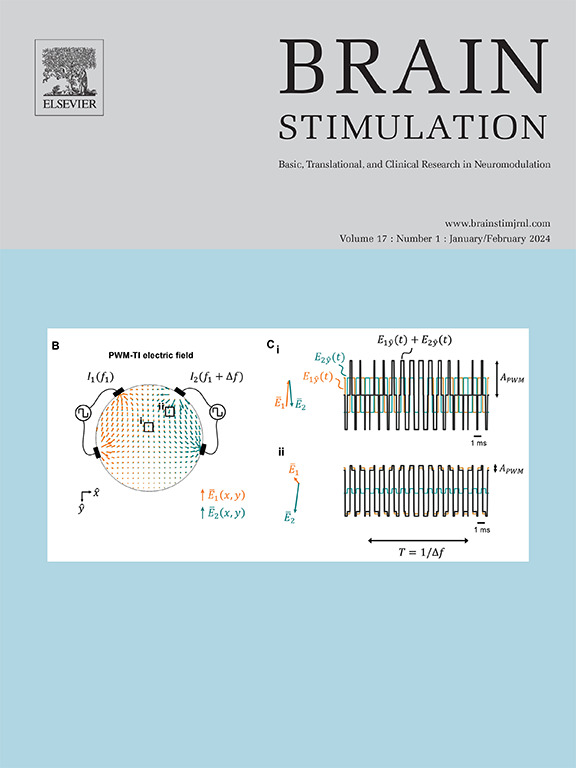Revisiting subcallosal cingulate deep brain stimulation for depression: Long-term safety and effectiveness outcomes from a pooled analysis of 172 implanted patients
IF 8.4
1区 医学
Q1 CLINICAL NEUROLOGY
引用次数: 0
Abstract
Objective
Deep brain stimulation (DBS) of the subcallosal cingulate (SCC) has been investigated clinically for treatment-resistant depression (TRD). Although the initial BROADEN study, a randomized controlled trial, was halted after an interim futility analysis, observation of long-term follow-up (LTFU) data from this and other cohorts demonstrated sustained improvement in depressive symptoms, prompting further investigation of DBS as a therapeutic option.
Methods
Data from 5 studies, including BROADEN, were used to evaluate the long-term safety and effectiveness of SCC DBS for TRD. Effectiveness measures included percent change in HDRS-17 and MADRS, response and partial response rate, and remission rate. Outcomes were assessed through five years post-implant, with primary analyses focused on the first 24 months due to attrition after this point. Sensitivity analyses were performed to evaluate robustness of the results, and adverse events were summarized.
Results
172 subjects were implanted in 5 studies across 5 countries. Average age was 47.9 years, 8.1 years in the current depressive episode, and 88 % had received electroconvulsive therapy (ECT). Effectiveness outcomes were analyzed through 24 months; additional data through five years are available in the supplement. Average MADRS reduction was 43 % at 12 months and 53 % at 24 months post-device activation, with response rates of 46 % and 55 %, and partial response rates of 13.3 % and 15.5 %, respectively. Observed case and sensitivity analyses for both MADRS and HDRS-17 showed a significant reduction in depressive symptoms at each follow-up visit. Safety data from four studies included 151 implanted subjects with 523 patient-years. Incidence of suicide was 0.55 per 100 patient-years.
Conclusions
Active SCC DBS shows continuous and sustained improvement in depressive symptomatology from the first year onward. While several limitations may impact the validity of these findings, SCC DBS has the possibility to provide a safe and durable treatment for TRD.
重新审视胼胝体下扣带深部脑刺激治疗抑郁症:172例植入患者的长期安全性和有效性结果汇总分析
目的探讨胼胝体下扣带(SCC)深部脑刺激(DBS)治疗难治性抑郁症(TRD)的临床疗效。尽管最初的拓宽研究(一项随机对照试验)在进行了中期无效分析后停止,但对该研究和其他队列的长期随访(LTFU)数据的观察显示,抑郁症状持续改善,这促使对DBS作为治疗选择的进一步研究。方法采用包括BROADEN在内的5项研究的数据,评价SCC DBS治疗TRD的长期安全性和有效性。有效性测量包括HDRS-17和MADRS的百分比变化、缓解率和部分缓解率以及缓解率。结果通过植入后5年进行评估,主要分析集中在植入后的前24个月由于磨损。进行敏感性分析以评估结果的稳健性,并总结不良事件。结果在5个国家的5项研究中植入了172名受试者。平均年龄为47.9岁,当前抑郁发作为8.1岁,88%接受过电休克治疗(ECT)。分析24个月的疗效结果;补充资料提供了5年的额外数据。器械激活后12个月MADRS平均降低43%,24个月平均降低53%,缓解率分别为46%和55%,部分缓解率分别为13.3%和15.5%。MADRS和HDRS-17的观察病例和敏感性分析显示,每次随访时抑郁症状显著减轻。安全性数据来自四项研究,包括151名植入受试者,523患者年。自杀率为0.55 / 100患者年。结论主动SCC DBS从第一年开始就显示出抑郁症状的持续改善。虽然一些限制可能会影响这些发现的有效性,但SCC DBS有可能为TRD提供安全和持久的治疗。
本文章由计算机程序翻译,如有差异,请以英文原文为准。
求助全文
约1分钟内获得全文
求助全文
来源期刊

Brain Stimulation
医学-临床神经学
CiteScore
13.10
自引率
9.10%
发文量
256
审稿时长
72 days
期刊介绍:
Brain Stimulation publishes on the entire field of brain stimulation, including noninvasive and invasive techniques and technologies that alter brain function through the use of electrical, magnetic, radiowave, or focally targeted pharmacologic stimulation.
Brain Stimulation aims to be the premier journal for publication of original research in the field of neuromodulation. The journal includes: a) Original articles; b) Short Communications; c) Invited and original reviews; d) Technology and methodological perspectives (reviews of new devices, description of new methods, etc.); and e) Letters to the Editor. Special issues of the journal will be considered based on scientific merit.
 求助内容:
求助内容: 应助结果提醒方式:
应助结果提醒方式:


